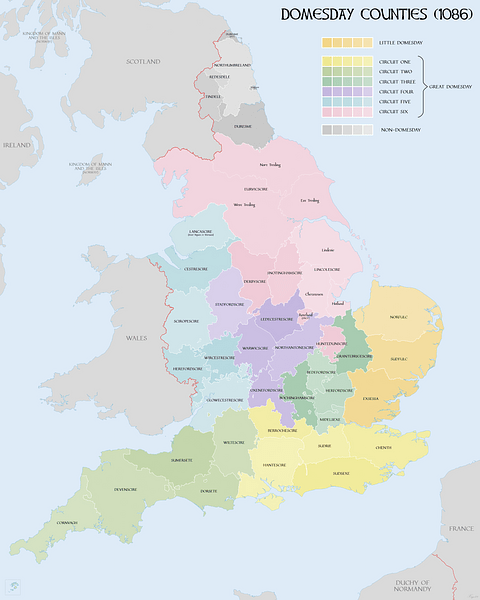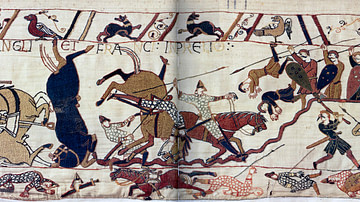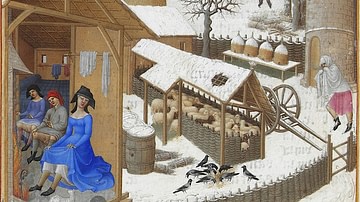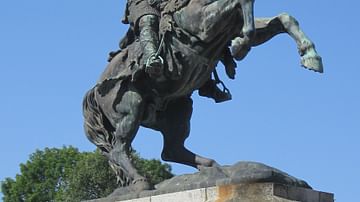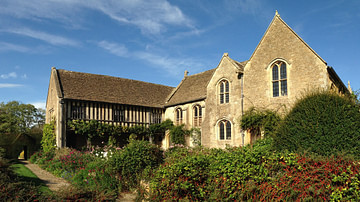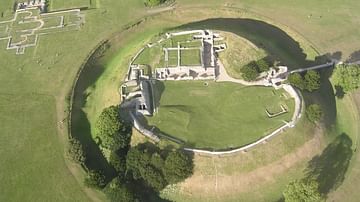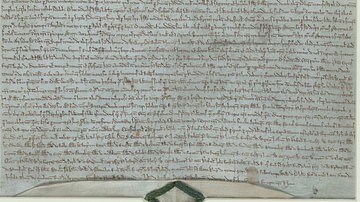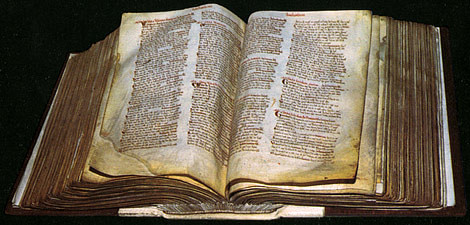
Domesday Book was a comprehensive survey and record of all the landowners, property, tenants and serfs of medieval Norman England. It was compiled in 1086-7 under the orders of William the Conqueror (r. 1066-87). The record is unique in European history and is packed full of statistics and snippets which reveal details of life in medieval England.
The precise purpose of the Domesday Book is not known but the most likely reason was to determine who legally owned what land, to settle disputes of ownership and to measure income, particularly agricultural income, in order to apply a future tax. The record continues to be invaluable to modern historians of medieval England. The two-volumed Domesday Book is currently housed in the UK National Archives, London.
Norman Britain
Domesday Book (the name usually appears without an article) reveals exactly what happened to the Anglo-Saxon nobility of England in the two decades following the Battle of Hastings in 1066 and the subsequent Norman conquest. William the Conqueror, the victor of that battle who was crowned the King of England in the same year on Christmas Day, took 20% of his new territory for himself. The other 80% went to tenants-in-chief (tenentes in capite), 1,100 new landowners as the old Anglo-Saxon landed aristocracy (those who had not been killed at Hastings) were swept aside and the Normans took over. Land, and consequently wealth, was also now in significantly fewer hands than before the conquest. Within this lucky 1,100 were 200 great barons and 300 higher members of the church hierarchy. Each received a parcel of land or rather an estate, also known as a 'manor', which was worked by serf peasants (aka 'villeins'). Often a great baron was given a number of manors which could then be individually distributed to a subtenant who was a lower aristocrat, the majority of whom were Normans. Another Norman creation was the shires (counties) with a sheriff (another Norman monopoly although the position was not hereditary) appointed in each to oversee the judicial, financial and military matters of their jurisdiction.
Name & Purpose
The name Domesday Book, commonly applied from the 12th century, may derive from 'doom', the term for a customary law in Anglo-Saxon England, or be a reference to the Day of Judgement, referred to in the Bible's book of Revelation, reminding that the records in Domesday Book were final and could not be disputed. The original 11th century name seems to have been more mundane: 'the book of the Exchequer' or 'the great book of Winchester'.
Domesday Book was compiled as a 'description of all England' (or all of Norman-controlled England) but a more precise motive than that has still not been agreed upon by scholars. One of the most popular suggestions as to its purpose is that it was designed to create a record against which taxes could be raised for the country's defence, as an invasion from Denmark then appeared imminent. Another possible reason was to ascertain lands were held by their rightful legal owner following the chaos of the Norman conquest which resulted in the deaths of Saxon lords in battle, confiscations of lands, gifts of estates from the king to loyal Normans and the grabbing of estates by any Normans bold enough to take them. It is perhaps significant that the records of Domesday Book are organised according to landowners and not parcels of lands that produce revenue, which makes it very time-consuming to calculate a particular individual's tax liability – if that was the sole purpose of the record. Finally, Domesday Book may have been compiled simply for William to know exactly who owned what in his kingdom. As the historian M. Morris puts it, the king now had a political weapon with which he could subdue any single rebellious baron for, in an instant, William could order the confiscation of all the lands that that baron held according to Domesday.
Gathering the Numbers
According to William's wishes, inspectors, likely under the supervision of William of St Calais, bishop of Durham, were sent out to cover groups of counties known as circuits. There the inspectors recorded all landowners, tenants, peasants, moveable property and each manor's annual incomes. There are some 30,000 manors recorded in the final document and each one was either subjected to a list of questions from the inspectors in person or a self-assessment in writing was studied. Witnesses were called in public sessions to verify all claims and existing documents were consulted to double and triple-check whether the figures were accurate. The inspectors were assisted in all this activity by local sheriffs and juries, who were made up 50-50 of Englishmen and Normans to ensure fairness in the disputed or doubtful claims, of which there were thousands. There was even a second round of inspections to ensure the first group of inspectors had not been corrupted in any way. Such measures would suggest Domesday Book was not, then, merely a census for tax purposes but was also designed to sort out the tricky question of who rightfully owned what land.
The officials eventually reported back to Winchester and had their findings written up in the royal writing office (scriptorium) there. As a result of all of these efforts, within a year, the king had a reasonably accurate and up-to-date record of all the country's assets – essentially a list of exactly who owned what and where in his newly redistributed kingdom which was then composed of up to 2 million people. Domesday Book is thus the oldest surviving national census in Europe, even if the lower classes were not represented by name.
Domesday Contents
Domesday Book was actually composed of two volumes. The first and larger volume of the survey, known as Great Domesday, deals with the counties of England south of the River Tees and the fells of Westmorland. Three counties are missing and appear in the slimmer but more detailed second volume: Norfolk, Suffolk and Essex. This second volume, Little Domesday, was probably meant to be reduced and its information added to the larger first volume but the work was not completed because of William's unexpected death in September 1087. The 832 pages or manuscript folios of the document are covered on both sides in close, plain script written in blank ink with the only colour being red ink used for groups of holdings or to highlight important points.
Catalogued according to shires and their subdivisions (known as the hundreds), Domesday Book exhaustively describes the royal estates each contained, lists all the landowners and sub-tenants, and notes who had a role in local borough- and town councils. The county of Suffolk, for example, is shown to have had its lands distributed amongst 76 landowners, all of whom are named from King William down to free men and include counts, one countess, bishops, abbots, priests, many long-forgotten aristocrats and even crossbowmen (recipients of the king's gratitude after battles, perhaps). Castles and churches are mentioned only incidentally as the focus of the survey was clearly on agricultural assets, the means to produce income from them, and who owned such wealth. Castles, with only a very few exceptions, were regarded as a cost, not a revenue source, while church lands would have been largely exempt from state taxes. Each manor is dealt with separately with a record of its means of production, the number of peasants (both free peasants and serfs), the livestock and equipment such as ploughs and mills. There is also, for each manor, an estimation of annual income.
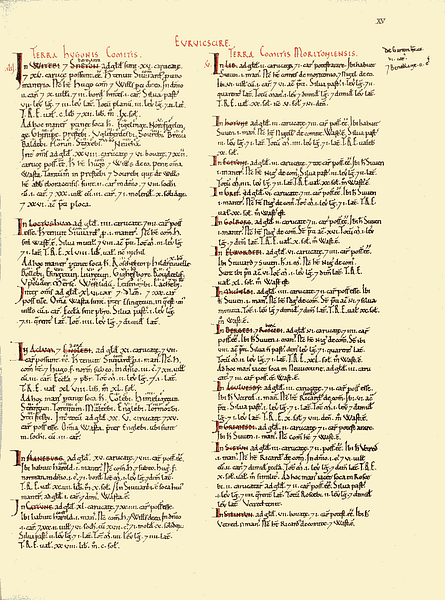
In the following extract from volume 2 of the survey we have a typical description of a property and its assets, in this case the lands of one Robert Malet in Suffolk. Robert's current assets are continuously measured against those of the previous owner, Edric of Laxfield.
Eye Edric held 12 carucates of land in the time of King Edward [the Confessor, r. 1042-1066 CE]. Now Robert holds them in demesne; and his mother holds 100 acres and 1 villein and 3 bordars [rank above serf but below a freeman] and 9 sokemen [category of freeman] with 16 acres, then 2 ploughs, now 1, worth 20s. Then 39 villeins, now 20. Then and afterwards 9 bordars, now 16. Then 12 serfs, now none. Then and afterwards 8 ploughs on the demesne, now 5. Then and afterwards 15 ploughs belonging to the men, now 6. And the other ploughs might be made up again. And 50 acres of meadow. Then wood [land] for 120 swine, now for 60. Then as now a mill. And a fishery. Then 7 rounceys [type of horse], now 1. Then 24 beasts, now none. Then 50 swine, now 17. Then 80 sheep, now 90. And now 1 market. And a park.
(quoted in Allen Brown, 162)
Aside from these rather dry property lists, Domesday Book does often contain more interesting asides such as descriptions of local customs or, as in this extract, the feudal system which required local landowners to present themselves for military service and/or provide warriors for the king's army:
If anyone summoned on an expedition did not go, he forfeited all his land to the king. And if anyone having a reason for staying behind promised to send another in his place, and that substitute failed to go, his lord was quit by the payment of 50 shillings.
(Vol. I, folio 56)
Legacy
As the historian Maurice Keen puts it, 'Norman direction, working within Anglo-Saxon traditions of local administration, had produced in Domesday Book the most complete survey ever made of the resources in men and wealth of a medieval kingdom' (107). Or, as the Anglo-Saxon Chronicle more bluntly states it: 'not one yard of land, nor indeed one ox nor one cow, nor one pig was there left out, and not put down in his [William's] record' (1085, quoted in Keen, 110). England would not see another such detailed survey until the 19th century. Domesday Book was kept in the Royal Treasury in Winchester until the 13th century, when it was moved to London. The records it contained were consulted and quoted in legal cases throughout the Middle Ages and even later, so much so that the very name Domesday Book acquired a power of its own as it came to represent an ultimate authority of record-keeping.
Domesday Book is a treasure trove of information for historians and reveals much about 11th century England. Studies of its figures reveal, amongst many others, such insights as:
- The names of 13,000 villages.
- That 90% of the population then lived in the countryside.
- That 75% of the population were serfs.
- The location of 50 castles, the number of properties destroyed to make way for them, and their association with markets.
- That many English lords had to buy back their lands from William after the conquest.
- That William could have assembled an army of around 16,000 fully armed warriors if needed.
Some technical terms in the documents remain unknown but as a snapshot of a medieval population, it is unrivalled in detail. Since the first binding in the 17th century, the folios of the manuscript have been rebound several times. In 1859 Domesday Book was moved again to its present home in the UK, National Archives, Kew, London, which provides an online version for consultation.
